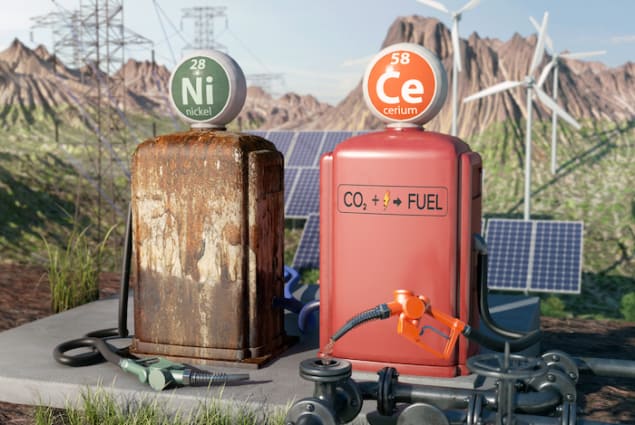
- This story is part of Covering Climate Now, a global collaboration of more than 250 news outlets to strengthen coverage of the climate story.
Carbon dioxide can be reduced to carbon monoxide with 100% selectivity in an electrochemical reaction using a cerium oxide catalyst. So say researchers at Stanford University in the US and the Technical University of Denmark (DTU) who have found that the process does not produce undesired solid carbon either – unlike conventional CO2 electrolysis technologies.
Re-using CO2 is an alternative to burying the greenhouse gas underground and could help in the development of a carbon-neutral sustainable energy economy. Electrochemically reducing CO2, for example, is a promising way to store the intermittent electricity produced from solar and wind power as chemicals such as synthetic hydrocarbons. These energy-dense carbon-neutral liquid fuels are compatible with existing petrol and diesel infrastructures and so could be employed in real-world applications.
The solid-oxide electrochemical cell
The most efficient CO2 electrolysis technology today is the solid-oxide electrochemical cell (SOC), which produces CO and O2. The key drawback to this technique, however, is the competition between CO generation and the deposition of solid carbon in the cell. The nickel electrocatalysts employed in the electrodes in this cell also encourage carbon formation during electrolysis and this carbon eventually fractures the porous electrodes, reducing their effective lifetime.
Researchers recently proposed using cerium oxide as an alternative to nickel in such fuel cell electrodes. A team led by Christopher Graves, William Chueh and Michal Bajdich has now found that cerium oxide inhibits the formation of carbon by trapping the carbon produced in the electrochemical reaction in a stable oxidized form.
Cerium oxide electrodes remain stable
The researchers obtained their result using X-ray photoelectron spectroscopy measurements during CO2 electrolysis using thin-film electrodes made of samarium-doped cerium oxide. They also performed density-functional theory calculations of CO2 reduction at elevated temperatures in this system. To compare, they repeated the same experiments on fuel cell electrodes made from conventional nickel-based materials and found that the cerium oxide electrodes remain stable while carbon deposits destroy the nickel ones.
Both the experiments and calculations show that carbon atoms are energetically trapped as oxidized carbon species relative to solid carbon, something that delays the formation and build-up of solid carbon, say the researchers. The abundant carbonates present on cerium oxide (which are absent in nickel-based materials) could also react and remove transiently deposited carbon to produce carboxylate in a surface-reverse Boudouard reaction, they add.
Improving device lifetime and lowering costs
“This remarkable capability of ceria has major implications for the practical lifetime of CO2 electrolyzer devices – both for fuel production on earth and for oxygen production on Mars,” says Graves, who is at DTU and who was a visiting scholar at Stanford during the study. “I’m on the science team for NASA’s Mars 2020 rover, which will make the first demonstration of oxygen production from Martian CO2. Replacing the current nickel electrode with our new ceria electrode in the next generation electrolyzer would improve device lifetime.”
Eliminating early cell death could significantly lower the cost of commercial CO production too, he adds. And that is not all: suppressing carbon build-up also allows the new type of device to convert more of the CO2 to CO, which is limited to well below 50 percent CO product concentration in conventional cells. This could also reduce production costs, he says.
Full details of the research are reported in Nature Energy 10.1038/s41560-019-0457-4.



